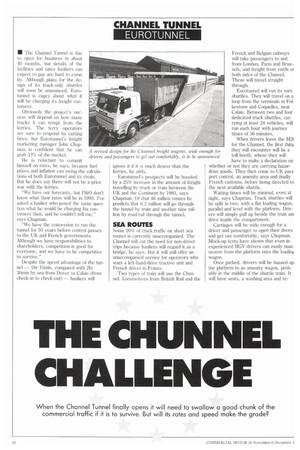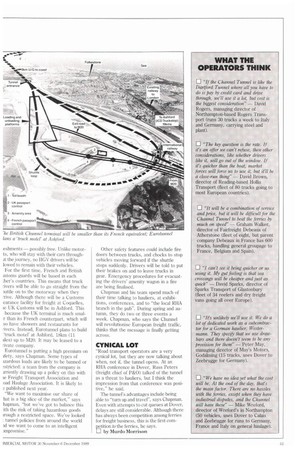CHANNEL TUNNEL EUROTUNNEL
Page 44

Page 45

If you've noticed an error in this article please click here to report it so we can fix it.
• The Channel Tunnel is due to open for business in about 40 months, but details of the facilities and rates hauliers can expect to pay are hard to come by. Although plans for the design of its truck-only shuttles will soon be announced, Eurotunnel is cagey about what it will he charging its freight customers.
Obviously the project's success will depend on how many trucks it can tempt from the ferries. The ferry operators are sure to respond by cutting fares. but Eurotunnel's freight marketing manager John Chapman is confident that he can grab 33% of the market.
He is reluctant to commit himself on rates, he says, because fuel prices and inflation can swing the calculations of both Eurotunnel and its rivals. But he does say there will not be a price war with the ferries.
"We have our forecasts, but P&O don't know what their rates will he in 1993. I've asked a haulier who posed the same question what he would be charging his customers then, and he couldn't tell me," says Chapman.
"We have the concession to run the tunnel for 55 years before control passes to the UK and French governments. Although we have responsibilities to shareholders, competition is good for everyone, and we have to be competitive to survive."
Despite the speed advantage of the tunnel — lhr 15min, compared with 2hr 30min by sea from Dover to Calais (from check-in to check-out) — hauliers will ignore it if it is much dearer than the ferries, he adds.
Eurotunnel's prospects will he boosted by a 25% increase in the amount of freight travelling by truck or train between the UK and the Continent by 1993, says Chapman. Of that 46 million tonnes he predicts that 6.2 million will go through the tunnel by train and another nine million by road/rail through the tunnel.
SEA ROUTES
Some 20% of truck traffic on short sea routes is currently unaccompanied. The Chunnel will cut the need for non-driver trips because hauliers will regard it as a bridge, he says. But it will still offer an unaccompanied service for operators who want a left-hand-drive tractive unit and French driver in France.
Two types of train will use the Chunnel. Locomotives from British Rail and the French and Belgian railways will take passengers to and from London, Paris and Brussels, and freight from yards or both sides of the Channel. These will travel straight through.
Eurotunnel will run its own shuttles. They will travel on a loop from the terminals in Folkestone and Coquelles, near Calais. Between two and four dedicated truck shuttles, carrying at least 24 vehicles, will run each hour with journey times of 36 minutes.
When drivers leave the M2( for the Chunnel, the first thing they will encounter will be a toll booth, where they will have to make a declaration on whether or not they are carrying hazardous goods. They then come to UK pass. port control, an amenity area and finally French customs, before being directed to the next available shuttle.
Waiting times will be minimal, even at night, says Chapman. Truck shuttles will be split in two, with a flat loading wagon, parallel and level with the platform. Drivers will simply pull up beside the train an drive inside the compartment.
Carriages will be wide enough for a driver and passenger to open their doors and get out comfortably, says Chapman. Mock-up tests have shown that even inexperienced HGV drivers can easily manoeuvre from the platform onto the loading wagon.
Once parked, drivers will be bussed up the platform to an amenity wagon, probably in the middle of the shuttle train. It will have seats, a washing area and re eshments — possibly free. Unlike motorts, who will stay with their cars throughit the journey, no IIGV drivers will be lowed to remain with their vehicles. For the first time, French and British istoms guards will be based in each tiler's countries. This means that truck rivers will be able to go straight from the iuttle on to the motorway when they 'rive. Although there will be a Customs earance facility for freight at Coquelles, te UK Customs will be in Ashford. This because the UK terminal is much smalr than its French counterpart, which will so have showers and restaurants for rivers. Instead, Eurotunnel plans to build 'truck motel' at Ashford, 18km (11 tiles) up to M20. It may be leased to a rivate company.
Eurotunnel is putting a high premium on ifety, says Chapman. Some types of izardous loads are likely to be banned or !stricted: a team from the company is irrently drawing up a policy on this with le Freight Transport Association and oad Haulage Association. It is likely to published next year.
"We want to maximise our share of hat is a big slice of the market," says hapman, "but we've got to balance this ith the risk of taking hazardous goods trough a restricted space. We've looked : tunnel policies from around the world id we want to come to an intelligent impromise." Other safety features could include fire doors between trucks, and chocks to stop vehicles moving forward if the shuttle stops suddenly. Drivers will be told to put their brakes on and to leave trucks in gear. Emergency procedures for evacuating the drivers amenity wagon in a fire are being finalised.
Chapman and his team spend much of their time talking to hauliers, at exhibitions, conferences, and to "the local RHA branch in the pub". During spring and autumn, they do two or three events a week. Chapman, who says the Chunnel will revolutionise European freight traffic, thinks that the message is finally getting across.
CYNICAL LOT
"Road transport operators are a very cynical lot, but they are now talking about when, not if, the tunnel opens. At an RHA conference in Dover, Russ Peters (freight chief of P&O) talked of the tunnel as a threat to hauliers. but I think the impression from that conference was positive," he said.
The tunnel's advantages include being able to "turn up and travel", says Chapman. Even with attempts to cut queues at Dover, delays are still considerable. Although there has always been competition among ferries for freight business, this is the first cornpetitkmi to the ferries, he says.
LI by Murdo Morrison
















































































































